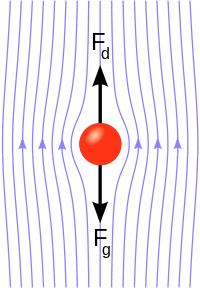
Stokes flow (named after George Gabriel Stokes), also named creeping flow or creeping motion,[1] is a type of fluid flow where advective inertial forces are small compared with viscous forces.[2] The Reynolds number is low, i.e. . This is a typical situation in flows where the fluid velocities are very slow, the viscosities are very large, or the length-scales of the flow are very small. Creeping flow was first studied to understand lubrication. In nature, this type of flow occurs in the swimming of microorganisms and sperm.[3] In technology, it occurs in paint, MEMS devices, and in the flow of viscous polymers generally.
The equations of motion for Stokes flow, called the Stokes equations, are a linearization of the Navier–Stokes equations, and thus can be solved by a number of well-known methods for linear differential equations.[4] The primary Green's function of Stokes flow is the Stokeslet, which is associated with a singular point force embedded in a Stokes flow. From its derivatives, other fundamental solutions can be obtained.[5] The Stokeslet was first derived by Oseen in 1927, although it was not named as such until 1953 by Hancock.[6] The closed-form fundamental solutions for the generalized unsteady Stokes and Oseen flows associated with arbitrary time-dependent translational and rotational motions have been derived for the Newtonian[7] and micropolar[8] fluids.
- ^ Kim, S. & Karrila, S. J. (2005) Microhydrodynamics: Principles and Selected Applications, Dover. ISBN 0-486-44219-5.
- ^ Kirby, B.J. (2010). Micro- and Nanoscale Fluid Mechanics: Transport in Microfluidic Devices. Cambridge University Press. ISBN 978-0-521-11903-0. Archived from the original on 2019-04-28. Retrieved 2010-01-15.
- ^ Dusenbery, David B. (2009). Living at Micro Scale. Harvard University Press, Cambridge, Massachusetts ISBN 978-0-674-03116-6
- ^ Leal, L. G. (2007). Advanced Transport Phenomena: Fluid Mechanics and Convective Transport Processes.
- ^ Chwang, A. and Wu, T. (1974). "Hydromechanics of low-Reynolds-number flow. Part 2. Singularity method for Stokes flows" Archived 2012-03-07 at the Wayback Machine. J. Fluid Mech. 62(6), part 4, 787–815.
- ^ Brennen, Christopher E. "Singularities in Stokes' Flow" (PDF). caltech.edu. p. 1. Archived from the original (PDF) on 10 September 2021. Retrieved 18 July 2021.
- ^ Shu, Jian-Jun; Chwang, Allen T. (2001). "Generalized fundamental solutions for unsteady viscous flows". Physical Review E. 63 (5): 051201. arXiv:1403.3247. Bibcode:2001PhRvE..63e1201S. doi:10.1103/PhysRevE.63.051201. PMID 11414893. S2CID 22258027.
- ^ Shu, Jian-Jun; Lee, J.S. (2008). "Fundamental solutions for micropolar fluids". Journal of Engineering Mathematics. 61 (1): 69–79. arXiv:1402.5023. Bibcode:2008JEnMa..61...69S. doi:10.1007/s10665-007-9160-8. S2CID 3450011.
